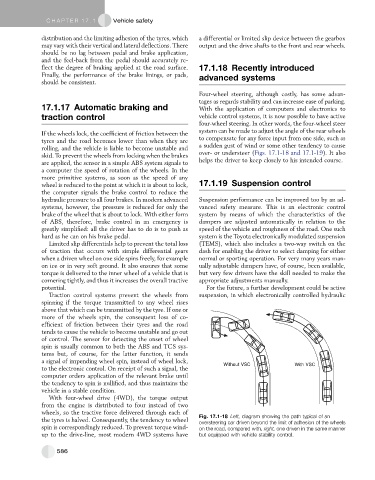Page 575 - Automotive Engineering Powertrain Chassis System and Vehicle Body
P. 575
CHAP TER 1 7. 1 Vehicle safety
distribution and the limiting adhesion of the tyres, which a differential or limited slip device between the gearbox
may vary with their vertical and lateral deflections. There output and the drive shafts to the front and rear wheels.
should be no lag between pedal and brake application,
and the feel-back from the pedal should accurately re-
flect the degree of braking applied at the road surface. 17.1.18 Recently introduced
Finally, the performance of the brake linings, or pads, advanced systems
should be consistent.
Four-wheel steering, although costly, has some advan-
tages as regards stability and can increase ease of parking.
17.1.17 Automatic braking and With the application of computers and electronics to
traction control vehicle control systems, it is now possible to have active
four-wheel steering. In other words, the four-wheel steer
system can be made to adjust the angle of the rear wheels
If the wheels lock, the coefficient of friction between the
tyres and the road becomes lower than when they are to compensate for any force input from one side, such as
rolling, and the vehicle is liable to become unstable and a sudden gust of wind or some other tendency to cause
skid. To prevent the wheels from locking when the brakes over- or understeer (Figs. 17.1-18 and 17.1-19). It also
are applied, the sensor in a simple ABS system signals to helps the driver to keep closely to his intended course.
a computer the speed of rotation of the wheels. In the
more primitive systems, as soon as the speed of any
wheel is reduced to the point at which it is about to lock, 17.1.19 Suspension control
the computer signals the brake control to reduce the
hydraulic pressure to all four brakes. In modern advanced Suspension performance can be improved too by an ad-
systems, however, the pressure is reduced for only the vanced safety measure. This is an electronic control
brake of the wheel that is about to lock. With either form system by means of which the characteristics of the
of ABS, therefore, brake control in an emergency is dampers are adjusted automatically in relation to the
greatly simplified: all the driver has to do is to push as speed of the vehicle and roughness of the road. One such
hard as he can on his brake pedal. system is the Toyota electronically modulated suspension
Limited slip differentials help to prevent the total loss (TEMS), which also includes a two-way switch on the
of traction that occurs with simple differential gears dash for enabling the driver to select damping for either
when a driven wheel on one side spins freely, for example normal or sporting operation. For very many years man-
on ice or in very soft ground. It also ensures that some ually adjustable dampers have, of course, been available,
torque is delivered to the inner wheel of a vehicle that is but very few drivers have the skill needed to make the
cornering tightly, and thus it increases the overall tractive appropriate adjustments manually.
potential. For the future, a further development could be active
Traction control systems prevent the wheels from suspension, in which electronically controlled hydraulic
spinning if the torque transmitted to any wheel rises
above that which can be transmitted by the tyre. If one or
more of the wheels spin, the consequent loss of co-
efficient of friction between their tyres and the road
tends to cause the vehicle to become unstable and go out
of control. The sensor for detecting the onset of wheel
spin is usually common to both the ABS and TCS sys-
tems but, of course, for the latter function, it sends
a signal of impending wheel spin, instead of wheel lock,
Without VSC With VSC
to the electronic control. On receipt of such a signal, the
computer orders application of the relevant brake until
the tendency to spin is nullified, and thus maintains the
vehicle in a stable condition.
With four-wheel drive (4WD), the torque output
from the engine is distributed to four instead of two
wheels, so the tractive force delivered through each of
Fig. 17.1-18 Left, diagram showing the path typical of an
the tyres is halved. Consequently, the tendency to wheel oversteering car driven beyond the limit of adhesion of the wheels
spin is correspondingly reduced. To prevent torque wind- on the road, compared with, right, one driven in the same manner
up to the drive-line, most modern 4WD systems have but equipped with vehicle stability control.
586

